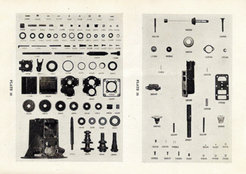Reconstructing the messaging platforms of our cells
By reconstructing cellular signaling pathways, researchers explore how our immune system evolved and inspire potential immunotherapies
Researchers from the Max-Planck-Institute for Infection Biology in Berlin reconstructed a signaling platform of the innate immune system. By building the signaling platform from the bottom up, they identified the minimal components required to transmit innate immune signals inside a cell. With this knowledge, the team also explored the potential of artificial signaling platforms, opening a research avenue for immunotherapy.

The immune system is all about information. Cells need to know if something is self or non-self, dangerous or not dangerous. And they need to process this information to trigger an appropriate response. In the innate immune system, information is transmitted by cascades of signaling molecules—also called signaling pathways—that can tell an organism the nature and extent of the threat it faces.
In the past decades, scientists have learned a lot about these pathways by taking them apart, often one signaling molecule at a time. We now have detailed maps of immune signaling pathways that are constantly expanded. A research group at the Max Planck Institute for Infection Biology in Berlin wanted to put this knowledge to the test. Instead of adding another signaling pathway to the map, they decided to change the perspective.
“Knowing the components, even knowing their order, does not necessarily mean you understand how something works,” explains Marcus Taylor, the research group leader behind the study: “To identify the essential biophysical properties of signaling pathways, we constructed a signaling platform from the bottom up.”
Reconstructing the cell’s central signaling platform
For their approach, the group chose a central structure of immune signaling: the signalosome. Signalosomes form inside cells in response to a stimulus and provide an assembly point for further signaling molecules. Depending on the stimulus, the amount and type of recruited signaling molecules can be modulated by signalosomes.
In our innate immune system, our first line of defense against infection, there are specialized signalosomes made up of long bundles of interconnected proteins. These bundles provide a scaffold for signaling molecules, and are essential for transmitting the signals that start the immune response. While these scaffolds share a common basic structure, they can be composed of proteins with a variety of functional parts, known as domain. This made it notoriously difficult to find the essential features or domains, making it difficult to determine a common mechanism for these signalosomes work.
“A parts list is not a construction manual”
“Imagine a car taken apart into its component parts. Without prior building experience, a parts list is not an instruction manual. It takes trial and error to build a moving vehicle. In the process you learn how the parts work together and you can distinguish if a part is essential or not,” says Taylor.
The group produced their own signalosomes by modifying DNA segments of known signalosome proteins. Step by step, the researchers reduced the structure of the signalosome, for example by fusing three individual protein domains into a single protein. They found this single protein could then assemble in a functional signalling bundle in response to a stimulus. With a lot of adjustment, they made it work. Inside isolated immune cells that were stripped of their natural immune signalosomes, the minimum signalosome was able to rescue the signalling cascade.
What constructing signaling pathways teaches us about evolution
After identifying the characteristics of the system, they began to test its limits. Now they were able to switch out components to see if signals would still be transmitted. The team's signalosome was derived from component found in mammalian cells, but from previous studies in different labs, the researchers knew that bacterial had protein scaffolds that were structurally related to the ones they used for construction.
"We knew that these proteins defend bacteria against viruses, so we wondered if these domains function in a similar way to those in the human immune system”, explains Taylor. When the team switched the proteins, the bacterial version would still transmit a signal in the mammalian system, even though billions of years of evolution lie between the two organisms. This suggests that bacterial and human immune system are using the same molecular mechanism.
Opening new research avenues for immunotherapy
The study may open another avenue of research: the possibility of developing therapeutic strategies based on the innate immune system. Because the researchers built the signaling platform from the bottom up, they knew what parts and properties are needed to make it work. By using a protein created by computer algorithms, the team found that a artificial protein scaffold could successfully replace the natural scaffold—a proof of concept for how the signaling platform could be designed to control signaling outputs.
This may allow scientists to program innate immune cells to attack targets such as cancer cells or pathogens that would otherwise go undetected. A similar concept has already been used to develop immunotherapies against cancer using modified cells of the adaptive immune system, known as CAR T cells.
